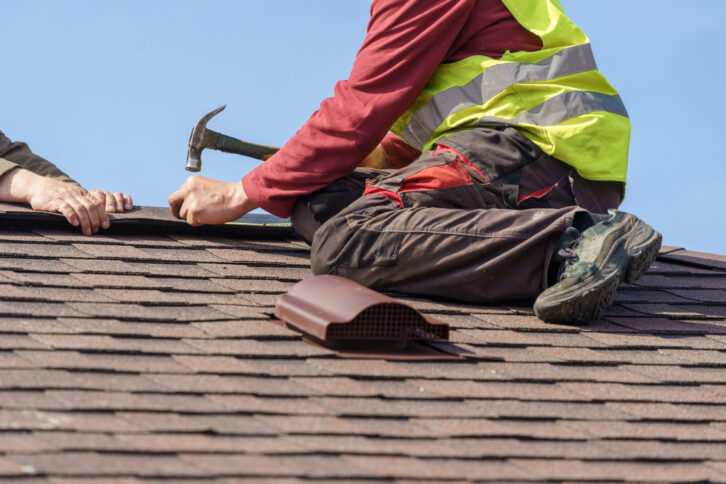
Your home should feel like a safe haven from the outside world—it’s literally the roof over your head. But when that roof is wearing out or damaged, and your credit score isn’t at its healthiest, you may feel like your home is less of a shelter from the storm and more of a money pit.
But don’t despair! Roof financing for bad credit is possible.
Read on as we help you make sense of your roof replacement financing options and weigh the pros and cons, so you can make the best decision for yourself and your shingles.
What Is Roof Financing?
Roof financing simply means taking out a loan in order to spread the cost of a new roof over time via a payment plan rather than paying a lump sum all at once.
Roof loans can be a great way to finance a new roof if you have bad credit because they’re typically easier to qualify for than unsecured loans. And as they’re often secured by your home, you may be able to get a lower interest rate than you would with an unsecured home improvement loan.
However, there are some risks to taking out a roof loan, particularly if your credit is poor:
- If you’re not able to make your monthly payments and you use your home as collateral, you could lose your home.
- Roof loans may be subject to variable interest rates, which means your payments could go up if rates rise.
- Roof loans often have a higher interest rate than a home equity loan or line of credit.
Can Roofs Be Financed With Bad Credit?
Good news: The simple answer is yes, new roof financing for bad credit can be done.
There are several ways you can borrow money to pay for roof repair or replacement—even if your credit score isn’t exactly through the roof. A few options to consider include:
- A loan from your bank or credit union
- A personal loan designed for those with poor credit
- A home equity loan
- A home equity line of credit (HELOC)1
- A home equity loan alternative like a sale-leaseback
No matter which option you choose, make sure you do your research and compare different offers before making a decision. An online loan calculator can help you compare offers from different lenders.
How to Finance a Roof With Bad Credit
If your roof is in immediate need of repair, you need to find a residential roofing financing solution quickly. But it’s vital to take time and do your due diligence. Taking out a home improvement loan with bad credit is a big decision, however, you have several alternatives to look into.
Here are some possibilities to begin your research:
- Bank loan – Your financial institution may be more willing to lend to you than another lender because you have an established relationship, even if your credit score is low. You can meet in person with a loan officer at your bank or credit union to discuss options.2 They will review factors like your account balance, deposit history, overdrafts, etc., which can give them a more complete picture of your financial responsibility.3
- Personal loan for bad credit – The interest rate on a personal loan will be higher if you have bad credit, but it is still possible to get approved for loans like home improvement loans with bad credit. Be very careful you fully understand the fees and terms of the loan option before signing. Check that your lender is reputable by consulting resources like the Consumer Financial Protection Bureau.4
- Home equity loan or HELOC – Another popular home remodel financing option is to finance the roof through a home equity loan or home equity line of credit (HELOC). If you have equity in your home, this can be a good option because you may be able to get a lower interest rate. If you do not have equity in your home, you may still be able to get a home equity loan or HELOC for home improvement, but your loan amount may be lower and the interest rate will be higher.1
- Government loan programs – Consider financing the roof through a government-backed loan program. The Department of Housing and Urban Development (HUD) offers a loan program for those with bad credit who need to make repairs to their home. The interest rate on a HUD loan is lower than the interest rate on a personal loan or home equity loan. Low- and moderate-income homeowners typically qualify for HUD loans.2
- Home equity loan alternative like a sale-leaseback– Depending on your circumstances, you might benefit from a sale-leaseback agreement, an alternative to home equity loans. With this new roof financing option, you can convert the home equity you’ve built up and use it to pay for the new roofing project—without moving out from under it. You also won’t have to take out a loan, so there’s nothing to pay back.
Key Takeaways
There are a few things to keep in mind when you’re considering residential roofing financing with bad credit. First, you’ll likely need to put down a larger down payment and pay a higher interest rate than you would if you had good credit. Because lenders see you as a higher risk, they minimize their own risk by charging higher rates and collecting more funds upfront. Consider options that don’t put you at a higher risk for borrowing and instead leverage your own equity like a sale-leaseback to finance your roof.
We recommend consulting with a financial advisor for help before you make a decision.
Sources:
- Forbes. Best roof financing options of 2022. https://www.forbes.com/advisor/personal-loans/best-roof-financing/
- Department of Housing and Urban Development. Fixing up your home and how to finance it. https://www.hud.gov/program_offices/housing/sfh/title/sfixhs
- Motley Fool. How to finance a roof. https://www.fool.com/the-ascent/personal-loans/how-to-finance/roof/
- Investopedia. Best loans for bad credit. https://www.investopedia.com/best-personal-loans-for-bad-credit-4774349#toc-guide-for-choosing-the-best-personal-loans-for-bad-credit



















